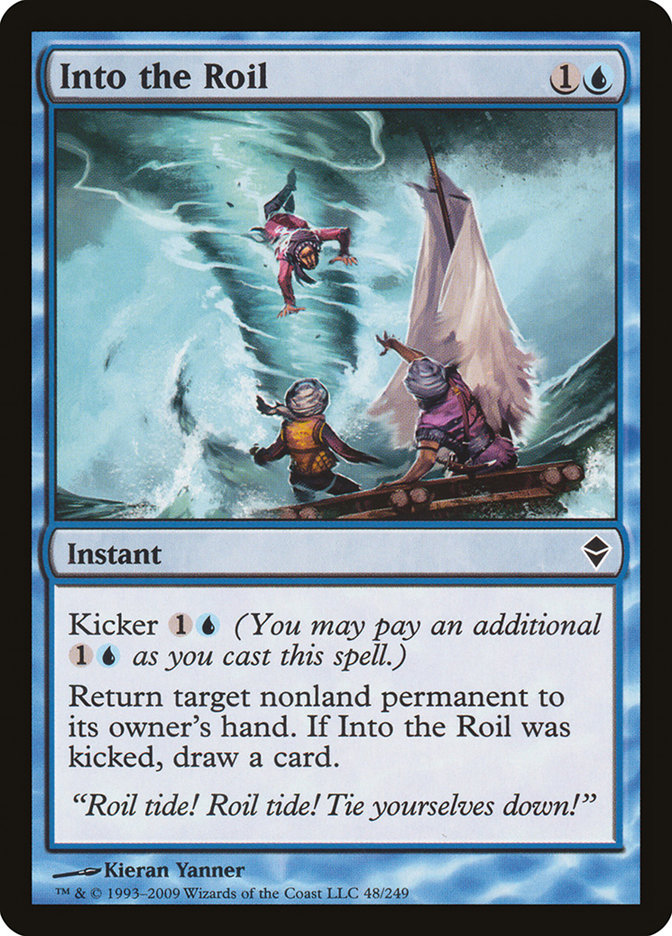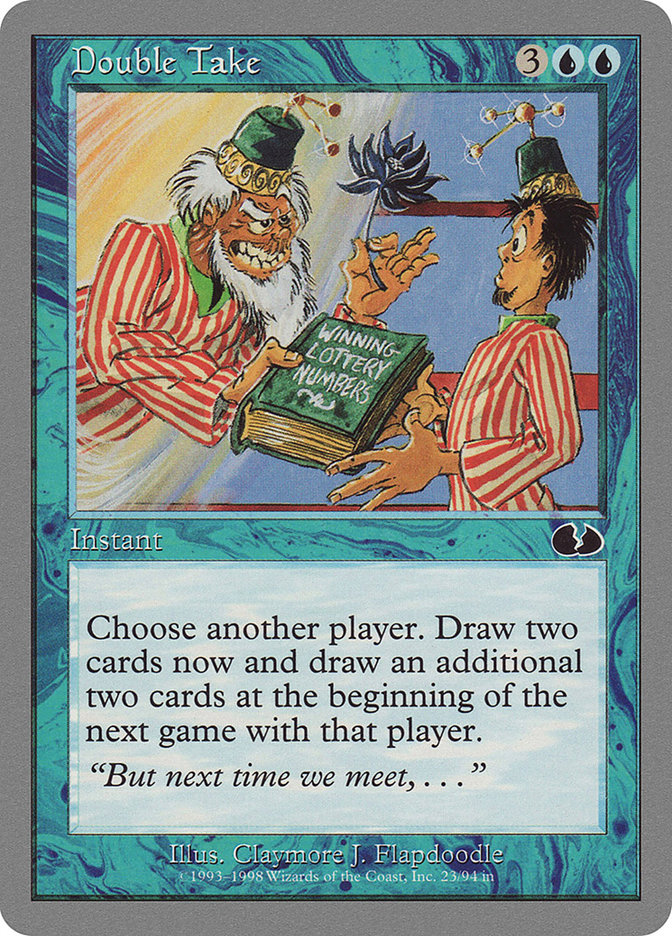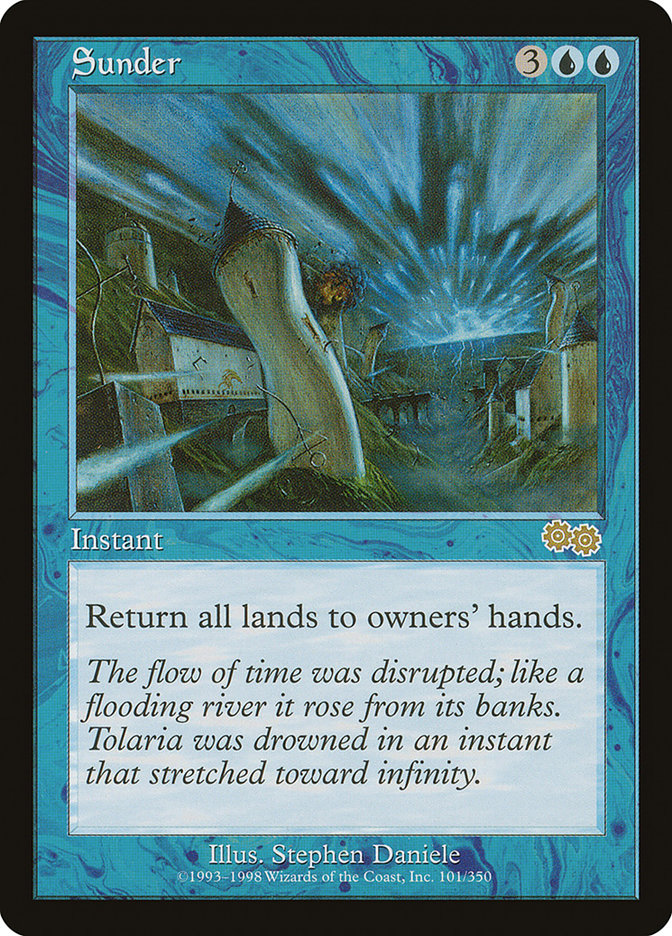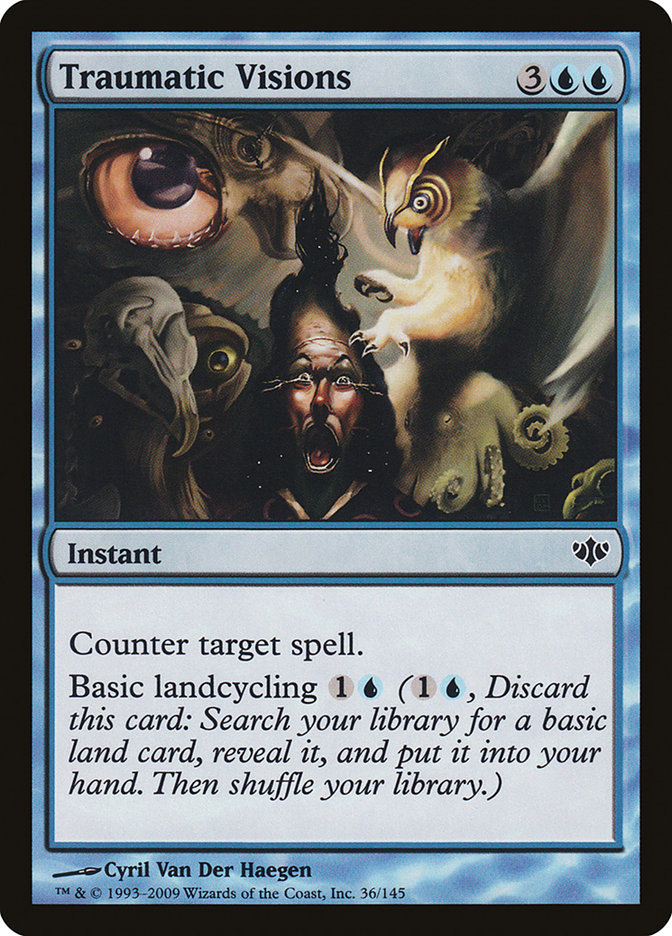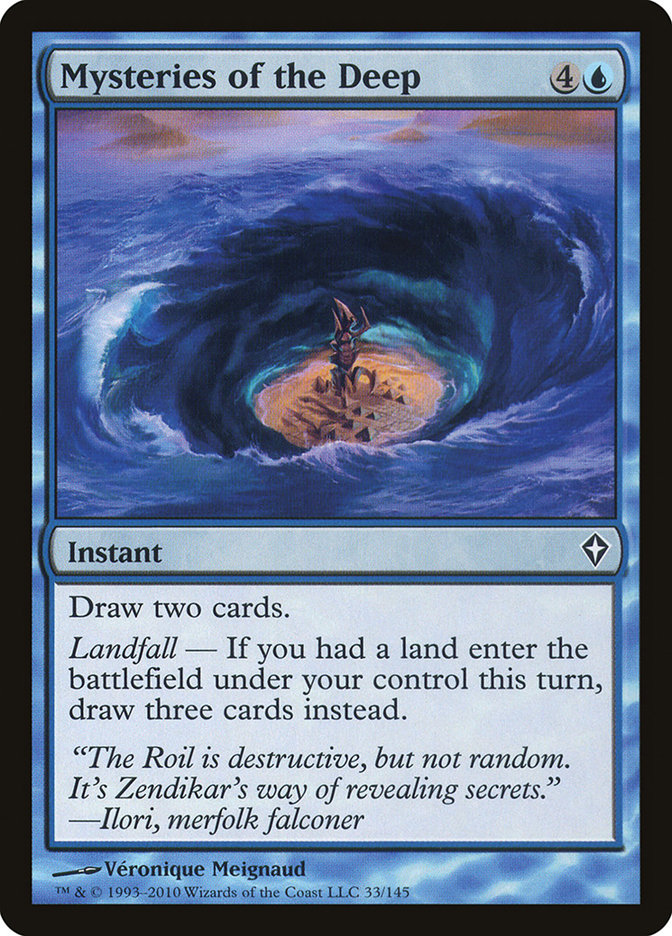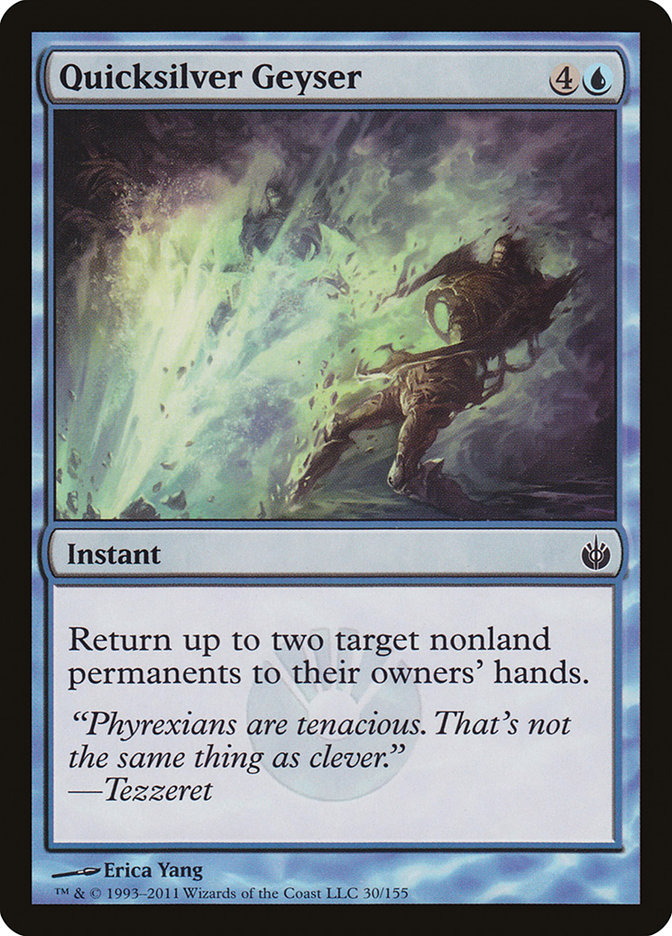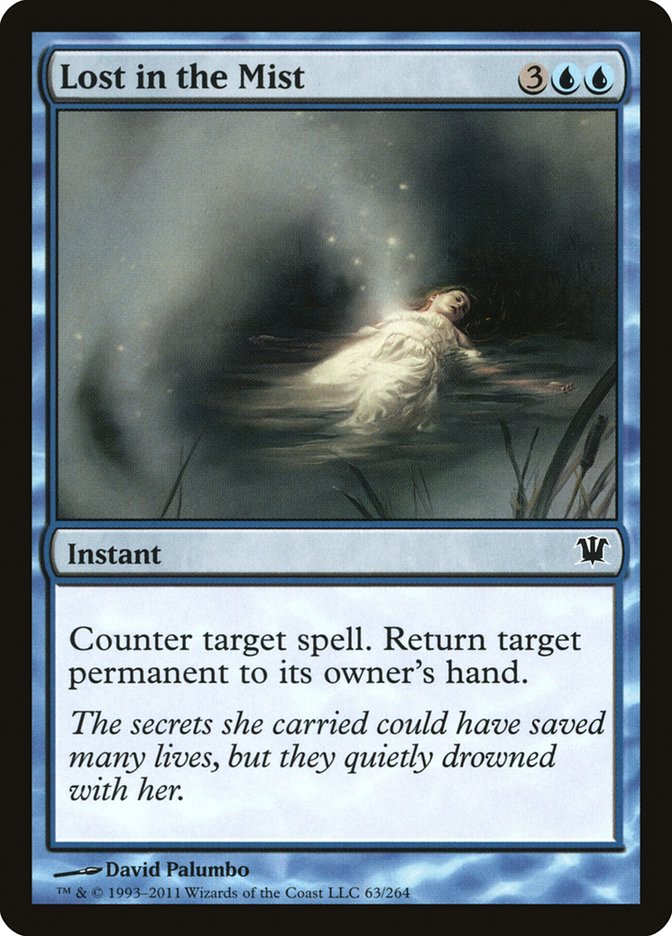Rito de retorno Carta MTG
| El coste de maná | |
| Costo de maná convertido | 5 |
| Rareza | Poco común |
| Tipo | Instantáneo |
| Habilidades | Delve |
| Liberado | 2015-01-23 |
| Coleccione símbolo | |
| Coleccione nombre | Fate Reforged |
| Coleccione código | FRF |
| Número | 49 |
| Frame | 2015 |
| Disposición | Normal |
| Border | Negra |
| Ilustrado por | Anastasia Ovchinnikova |
Texto de la carta
Excavar. (Cada carta que exilies de tu cementerio al lanzar este hechizo cuenta como un pago de {1}.) Regresa el permanente objetivo que no sea tierra que controlas y el permanente objetivo que no sea tierra que no controlas a las manos de sus propietarios.
Cartas Similares
Rito de Deshacer es un hechizo intrigante en Magic: The Gathering que comparte similitudes con otros efectos de retorno en el juego. Al igual que Into the Roil, Rite of Undoing puede devolver un permanente que no sea tierra al a mano de su dueño. Mientras que Into the Roil se puede lanzar por dos manás o aumentar su coste a cuatro para también robar una carta, Rite of Undoing destaca por su habilidad de escarbar, lo que permite a un jugador potencialmente reducir su coste de cinco manás exiliando cartas de su cementerio.
Otra carta con funcionalidad comparable es Sátiro Viajero. Aunque no afecta directamente al campo de batalla como Rite of Undoing, el Sátiro permite desactivar tierras, lo cual puede ser un movimiento estratégico para jugadas de tempo. Sin embargo, Rite of Undoing ofrece una interacción más directa al afectar directamente al estado del tablero y potencialmente proporcionar un cambio considerable en el tempo.
Seleccionar el hechizo correcto para tu mazo requiere considerar las implicaciones estratégicas de cada uno. Rite of Undoing puede ser una inclusión poderosa, especialmente en mazos que llenan rápidamente el cementerio y pueden aprovechar su mecánica de escarbar para lograr una eficiencia máxima y un cambio sorpresa potencial durante una partida tensa.
Cartas similares a Rito de retorno por color, tipo y coste de maná
Aspectos positivos de la carta
Ventaja de cartas: Rite of Undoing ofrece una oportunidad primordial para equilibrar tu mano al devolver un permanente que no es tierra a la mano de su dueño. Esto puede interrumpir las jugadas de tu oponente o devolver un permanente valioso tuyo para reutilización, fomentando en última instancia la ventaja de cartas en el campo de batalla.
Aceleración de recursos: En mazos donde los permanentes pueden ser jugados nuevamente o donde las criaturas entran al campo de batalla con efectos beneficiosos, esta carta puede ser un catalizador. Prepara el terreno para volver a desencadenar efectos de entrada al campo de batalla, acelerando tu utilización de recursos sin perder economía de cartas.
Velocidad instantánea: La capacidad de lanzar Rite of Undoing a velocidad instantánea proporciona una flexibilidad táctica crucial. Puedes responder a los movimientos de tu oponente, sorprenderlos deshaciendo una jugada clave en un momento crucial, o simplemente hacer un movimiento ventajoso antes de que pase el turno, todo sin tener que comprometerte con tu propio turno.
Aspectos negativos de la carta
Requisito de descarte: Rite of Undoing requiere que exilias una carta azul de tu mano; este es un precio elevado a pagar y puede llevar a una disminución en la ventaja de mano, poniéndote en una potencial desventaja frente a tu oponente.
Coste de mana específico: El coste de lanzamiento de Rite of Undoing no solo es específico de color, sino que también incluye mana azul, lo que significa que no es universalmente flexible y requiere una base de mana azul dedicada para jugar efectivamente.
Coste de mana comparativamente alto: Con un coste de cuatro manas, que incluye tres genéricos y uno azul, Rite of Undoing compite con numerosos otros hechizos en ese rango de manas. Muchas alternativas ofrecen un efecto más impactante o no vienen con el coste adicional de exiliar una carta azul.
Razones para incluir en tu colección
Versatilidad: Rite of Undoing ofrece adaptabilidad en diversas construcciones de mazos que valoran la capacidad de respuesta y la interacción. Esta carta ofrece flexibilidad, permitiendo a los jugadores devolver tanto sus propios permanentes como los de un oponente, perfecto para ajustes estratégicos sobre la marcha.
Potencial de combo: Como un instantáneo con el mecanismo de Delve, Rite of Undoing puede encajar en estrategias diseñadas para maximizar el beneficio de cartas en el cementerio. Puede sinergizar perfectamente con la estrategia general del mazo de autodestrucción o manipulación del cementerio, ampliando aún más tus posibilidades tácticas.
Relevancia meta: Especialmente en un meta cargado de Auras, Equipamiento y otros tipos de permanentes que los jugadores desean conservar o volver a jugar, Rite of Undoing ofrece una ventaja. Su capacidad para interrumpir las configuraciones de los oponentes mientras protege tus propios activos de la eliminación puede cambiar los juegos a tu favor.
Cómo vencer
Rite of Undoing es una carta versátil de Magic: The Gathering que ofrece la capacidad de devolver un permanente que no es tierra a la mano de su dueño. El aspecto único de Rite of Undoing radica en su mecanismo de Delve, que permite a un jugador exiliar cartas de su cementerio para ayudar a pagar el coste de mana del hechizo. Esto puede convertir un cementerio tardío en un recurso, lanzando potencialmente este hechizo por un solo mana azul.
Para contrarrestar efectivamente a Rite of Undoing, es crucial limitar los recursos del cementerio del oponente que alimentan el mecanismo de Delve. Estrategias como utilizar cartas de odio del cementerio que exilian o restringen la interacción con el cementerio pueden sofocar la eficiencia del hechizo. Además, mantener un estado de tablero diverso y resistente hace que el contratiempo temporal de tener un permanente devuelto a la mano sea menos impactante. Los contrahechizos también son una forma directa de evitar que Rite of Undoing se resuelva, asegurando que tu presencia en el tablero permanezca intacta.
Comprender las complejidades de las fortalezas y debilidades de Rite of Undoing permite a los jugadores anticipar y neutralizar la influencia del hechizo en el juego. Al mantener el cementerio del oponente bajo control y proteger amenazas significativas, la ventaja obtenida al lanzar este hechizo complicado puede ser mitigada.
Donde comprar
Si estás buscando comprar una carta MTG Rito de retorno de un coleccione específico como Fate Reforged, existen varias opciones confiables que debes considerar. Una de las fuentes principales es tu tienda de juegos local, donde a menudo puedes encontrar paquetes de refuerzo, cartas individuales y mazos preconstruidos de colecciones actuales y pasadas. A menudo ofrecen el beneficio adicional de una comunidad donde puedes intercambiar con otros jugadores.
Para un inventario más amplio, particularmente de colecciones más antiguos, mercados en línea como TCGPlayer, Card Kingdom y Card Market ofrecen amplias selecciones y te permiten buscar cartas de colecciones específicos. Las plataformas de comercio electrónico más grandes como eBay y Amazon también tienen listados de varios vendedores, lo que puede ser un buen lugar para buscar productos sellados y hallazgos raros.
Además, el sitio oficial de Magic suele tener un localizador de tiendas y listas de minoristas para encontrar Wizards of the Productos con licencia costera. Recuerde comprobar la autenticidad y el estado de las cartas al comprarlas, especialmente a vendedores individuales en mercados más grandes.
A continuación se muestra una lista de algunos sitios web de tiendas donde puede comprar las Rito de retorno y otras cartas MTG:
 COMPRAR
COMPRAR BurnMana es un socio oficial de TCGPlayer
- eBay
- Card Kingdom
- Card Market
- Star City Games
- CoolStuffInc
- MTG Mint Card
- Hareruya
- Troll and Toad
- ABU Games
- Card Hoarder Magic Online
- MTGO Traders Magic Online
Ver productos MTG
Legalidades
Formatos de Magic the Gathering donde Rito de retorno tiene restricciones
| Formato | Legalidad |
|---|---|
| Commander | Legal |
| Legacy | Legal |
| Modern | Legal |
| Oathbreaker | Legal |
| Vintage | Legal |
| Duel | Legal |
| Pioneer | Legal |
| Penny | Legal |
Reglas e información
La guía de referencia para las reglas de las cartas Rito de retorno de Magic: The Gathering proporciona las reglas oficiales, las erratas emitidas, así como un registro de todas las modificaciones funcionales que se han producido.
| Fecha | Texto |
|---|---|
| 24/11/2014 | Porque la habilidad de escarbar no es un coste alternativo, se puede usar junto con costes alternativos. |
| 24/11/2014 | Delve no cambia el coste de maná de un hechizo o su coste de maná convertido. Por ejemplo, el coste de maná convertido de la Crueldad de Tasigur (con un coste de maná ) es 6 incluso si exilias tres cartas para lanzarlo. |
| 24/11/2014 | No puedes desterrar cartas para pagar los requisitos de mana de color de un hechizo con exiliar. |
| 24/11/2014 | No puedes desterrar más cartas que el coste de maná genérico de un hechizo con saquear. Por ejemplo, no puedes desterrar más de cinco cartas de tu cementerio para lanzar la Crueldad de Tasigur. |
| 24/11/2014 | Exilias cartas de tu cementerio al mismo tiempo que pagas el coste del hechizo. Exiliar una carta de esta manera es simplemente otra forma de pagar ese coste. |

